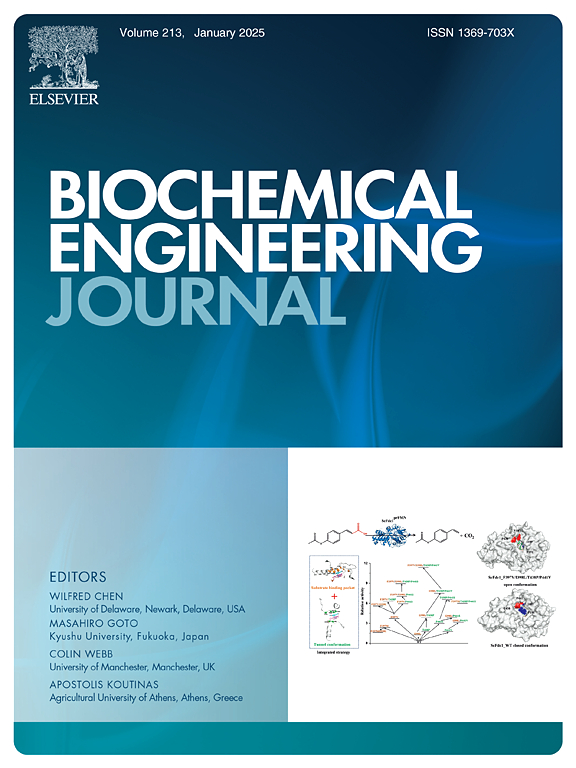Biochemical production from sustainable carbon sources by Komagataella phaffii
IF 3.7
3区 生物学
Q2 BIOTECHNOLOGY & APPLIED MICROBIOLOGY
引用次数: 0
Abstract
The use of sustainable carbon sources (SCSs) for biochemical production is needed to facilitate the chemical process industries transition towards the net-zero age and greener economy. The use of SCSs such as crude glycerol, ethanol, methanol, acetate, lactate, and formate offers potential cost reduction and sustainability benefits. However, the integration of SCSs into bioindustries is generally challenged by their low uptake rates, toxicity, and the metabolic stress they exert. Therefore, their transport rates from fermentation medium into the cell and then sequential intracellular reaction rates towards target products need to be fine-tuned. This review begins with the importance of use of SCSs in biochemical process industries and continues with the current state of metabolic engineering strategies employed to optimize biochemical and recombinant protein production. In turn, metabolic engineering strategies to increase the uptake rates of two SCSs, ethanol and acetate, and the carbon fluxes fueling the TCA cycle in Komagataella phaffii (Pichia pastoris) are discussed. Moreover, the latest findings on bioreactor operation condition optimization are compiled with a special emphasis on recombinant protein production. We conclude that the future of K. phaffii-based bioprocessing lies in integrating metabolic and bioreactor engineering with systems biology, while advances in synthetic biology, such as modular genome editing and machine learning for promoter and pathway design, will further refine the metabolic versatility of K. phaffii.
利用可持续碳源进行生化生产的Komagataella phaffii
为了促进化学过程工业向净零时代和绿色经济过渡,需要在生化生产中使用可持续碳源(scs)。使用粗甘油、乙醇、甲醇、醋酸盐、乳酸盐和甲酸盐等SCSs可以降低成本,并具有可持续性效益。然而,将SCSs整合到生物工业中通常受到低吸收率、毒性和代谢压力的挑战。因此,它们从发酵介质进入细胞的运输速率以及随后对目标产物的细胞内顺序反应速率需要进行微调。本文首先介绍了在生化过程工业中使用SCSs的重要性,然后介绍了用于优化生化和重组蛋白生产的代谢工程策略的现状。进而,代谢工程策略,以提高两种SCSs,乙醇和醋酸盐的吸收率和碳通量燃料的法菲氏酵母(毕赤酵母)的TCA循环进行了讨论。此外,还汇编了生物反应器操作条件优化的最新研究成果,特别强调了重组蛋白的生产。我们得出结论,基于法菲氏菌的生物处理的未来在于将代谢和生物反应器工程与系统生物学相结合,而合成生物学的进步,如模块化基因组编辑和启动子和途径设计的机器学习,将进一步完善法菲氏菌的代谢多功能性。
本文章由计算机程序翻译,如有差异,请以英文原文为准。
求助全文
约1分钟内获得全文
求助全文
来源期刊

Biochemical Engineering Journal
工程技术-工程:化工
CiteScore
7.10
自引率
5.10%
发文量
380
审稿时长
34 days
期刊介绍:
The Biochemical Engineering Journal aims to promote progress in the crucial chemical engineering aspects of the development of biological processes associated with everything from raw materials preparation to product recovery relevant to industries as diverse as medical/healthcare, industrial biotechnology, and environmental biotechnology.
The Journal welcomes full length original research papers, short communications, and review papers* in the following research fields:
Biocatalysis (enzyme or microbial) and biotransformations, including immobilized biocatalyst preparation and kinetics
Biosensors and Biodevices including biofabrication and novel fuel cell development
Bioseparations including scale-up and protein refolding/renaturation
Environmental Bioengineering including bioconversion, bioremediation, and microbial fuel cells
Bioreactor Systems including characterization, optimization and scale-up
Bioresources and Biorefinery Engineering including biomass conversion, biofuels, bioenergy, and optimization
Industrial Biotechnology including specialty chemicals, platform chemicals and neutraceuticals
Biomaterials and Tissue Engineering including bioartificial organs, cell encapsulation, and controlled release
Cell Culture Engineering (plant, animal or insect cells) including viral vectors, monoclonal antibodies, recombinant proteins, vaccines, and secondary metabolites
Cell Therapies and Stem Cells including pluripotent, mesenchymal and hematopoietic stem cells; immunotherapies; tissue-specific differentiation; and cryopreservation
Metabolic Engineering, Systems and Synthetic Biology including OMICS, bioinformatics, in silico biology, and metabolic flux analysis
Protein Engineering including enzyme engineering and directed evolution.
 求助内容:
求助内容: 应助结果提醒方式:
应助结果提醒方式:


